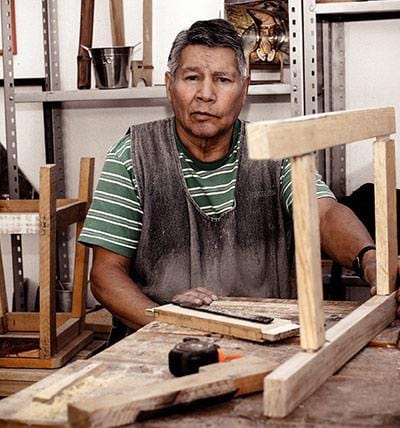CNC (computer numerical control) machines have transformed woodworking, offering unparalleled precision and creative possibilities for wood engraving.
But achieving exceptional results in CNC wood engraving requires technical expertise and artistic finesse.
This guide will explore essential techniques to help you master this craft efficiently.
Understanding the Basics of CNC Wood Engraving
Before diving into advanced techniques, it's crucial to grasp the fundamentals of CNC wood engraving.
Here's a concise overview:
CNC Machine Familiarity: Begin by acquainting yourself with your CNC machine's software interface and consulting the user manual for maintenance and troubleshooting guidance. Whether you're using a larger industrial CNC machine or a more compact desktop CNC mill, understanding its operation is essential.
Wood Selection: Experiment with various wood types to understand their unique characteristics and interaction with your designs. Exotic woods like padauk or zebrawood can add distinctive colors and grain patterns.

Tool Selection: Regarding tool selection, consider two essential factors. First, ensure the tool's material compatibility matches the hardness of the wood you're engraving, significantly impacting quality. Second, make sure your chosen tool's diameter and depth capacity aligns with your design's requirements for the best results.
Material Consideration: Moisture content affects the wood's hardness and interaction with the cutting tool. Woods with high moisture levels may require adjustments to cutting parameters such as feed rate and depth of cut to ensure optimal engraving results. Monitoring and adjusting your settings based on the wood's moisture content is essential for achieving consistent quality in your engravings.
Toolpath Optimization: Experiment with advanced toolpath strategies, like scalloping or trochoidal milling, to create intricate textures and depth. A milling machine can be particularly useful for achieving precise and detailed results in your wood engravings.
Depth Control: Utilize your machine's probing or sensor capabilities to measure the wood's surface and automatically adjust engraving depth for irregular workpieces, ensuring consistent quality.
Text Engraving Tips: Experiment with text placement, alignment, orientation, font styles, and sizes to achieve unique artistic effects and seamlessly integrate your overall design.
Engraving Process and Toolpath Creation
Regardless of the software you use, the engraving process follows a consistent set of steps:
- Design Import or Creation: The first step is to import your existing design or create a new one within your chosen design software. This serves as the foundation for your engraving project, and you can use various design tools to create intricate patterns, text, or artwork.
- Toolpath Assignment: Next, you'll need to assign a toolpath to each vector within the design. A toolpath refers to instructions that guide your CNC engraving machine on how to follow the contours of your design. For wood engraving, the most common toolpath is a 2D contour.
- Running the CNC Machine: Now, you're ready to run your CNC engraving machine. Its precision and accuracy come into play as it precisely follows the designated toolpaths to engrave your design onto the wood surface.
The beauty of engraving toolpaths is that they directly follow the design vectors, simplifying the toolpath creation process. Unlike other CNC processes where the order of cutting or direction of the tool matters greatly, engraving toolpaths can be considered pen strokes. They’re designed to seamlessly follow the design contours, making them suitable for open and closed vectors.
Mastering these fundamental aspects of CNC wood engraving will build a strong foundation for creating intricate and visually stunning designs.
Advanced Techniques for CNC Wood Engraving
With the basics covered, let's explore advanced techniques that will elevate your CNC wood engraving:

Depth Control and Gradation: Create captivating textures and emphasize focal points by experimenting with varying depths, adding visual interest to your designs.
Inlay Techniques: Combine materials like metals or wood to produce intricate patterns and designs, offering a unique blend.
3D Wood Engraving: Transform flat wood surfaces into textured relief sculptures using 3D wood engraving techniques. To achieve even more intricate and realistic results, consider experimenting with different cutter shapes and sizes, as they can significantly impact the level of detail and depth in your 3D engravings.
Multicolor Engraving: Experiment with different stains or paints to highlight specific design areas, producing stunning visual effects and making your engravings stand out.
Custom Jigs and Fixtures: When engraving irregular or delicate workpieces, custom jigs and fixtures ensure precise results.
Explore these advanced techniques to enhance your CNC wood engraving skills and allow for intricate and artistic design creation.
Tips for Precision and Efficiency
Attaining exceptional CNC wood engraving results requires meticulous attention to detail and efficiency in your workflow. Here are some tips:
- Test Cuts: Before working on your final piece, consider conducting test cuts on similar scrap wood. These preliminary cuts serve as valuable experiments to fine-tune settings such as feed rate, spindle speed, and depth of cut. By doing so, you can achieve optimal engraving results without the risk of compromising your project.
- Proper Dust and Chip Management: Installing a dust collection system or utilizing a vacuum attachment can help you effectively manage wood chips and dust. By preventing debris interference, you ensure your machine operates smoothly and consistently, leading to high-quality engravings.
- Optimize Speeds and Feeds: Dialing in the right feed rate and spindle speed settings is essential for CNC wood engraving. These settings should be tailored to your specific CNC machine, tooling, and the type of wood you're working with. The correct balance between feed rate and spindle speed helps prevent issues like burning wood or excessive tear-out.
These tips will help you achieve precision and efficiency, ensuring exceptional CNC wood engraving results.
Tool Maintenance
Tool maintenance is critical in CNC wood engraving, ensuring consistent and quality results.
Follow these best practices:
- Regularly inspect cutting tools for wear, such as dull edges or chipped flutes.
- Clean tools after each use to remove wood resin and dust that can affect performance.
- Measure tool diameter with calipers to check for excessive wear.
- Promptly replace worn tools to maintain engraving quality.
- Keep a spare tool set on hand to minimize project downtime.
- Implement a tool-tracking system for efficient maintenance and replacements.
By adhering to these essential tool maintenance guidelines, you'll extend the life of your cutting tools while enhancing the precision of your CNC wood engraving projects.
Troubleshooting and Adjustments
Mastering CNC wood engraving includes the ability to troubleshoot and make necessary adjustments when issues arise:
- Machine Calibration and Alignment: Misaligned components can lead to inaccurate engraving. Regularly calibrate and align your CNC machine per the user manual's instructions.
- Material Considerations: Wood moisture content and variations in hardness can impact engraving. Adjust cutting parameters for high-moisture content wood and ensure a clean and secure workpiece.
- Software Verification: Errors in design files or programming can lead to unintended results. Verify your design, toolpaths, and CNC machine programming. Perform test cuts on scrap wood to identify and rectify software-related issues.
- Depth Consistency: To ensure even engraving depth, utilize your CNC machine's probing or sensor capabilities for irregular workpieces.
- Vibration and Stability: Keep your CNC machine on a stable surface, free from external factors causing vibrations. Regularly check for loose components.
- Minimize Chipping or Tear-Out: Experiment with tool geometries and cutting parameters for specific wood types to reduce chipping or tear-out. Adjust spindle speed and feed rate as needed.
Preparing to troubleshoot and adjust during CNC wood engraving projects ensures you can achieve outstanding results, even in unexpected challenges.
Unleash Your Creativity
While mastering the technical aspects is crucial, don't forget to nurture your creative side:
- Design Original Artwork: Develop a signature style by creating unique designs that set your work apart.
- Combine CNC with Handwork: Blend CNC engraving with hand carving or finishing touches to create personalized and remarkable pieces.
- Text Engraving Tips: When engraving text, select fonts, alignment, and orientation that complement your overall design.
Incorporating these creative elements into your CNC wood engraving projects will set your work apart and allow you to express your artistic vision.
Building Your Expertise
Mastering CNC wood engraving is an ongoing journey. Here are steps to build your expertise:
- Practice Regularly: Work on various projects to gain experience with different wood types, designs, and techniques.
- Learn from Others: Connect with fellow CNC wood engravers through online forums, social media groups, or woodworking clubs to accelerate your skills and gather fresh ideas.
- Document Your Projects: Maintain detailed project records, including settings, designs, and techniques, to track progress and aid future projects.
- Invest in Continued Learning: Consider attending workshops or courses on CNC woodworking and engraving to stay updated on the latest techniques and technologies.
Developing expertise in CNC wood engraving is a fulfilling journey that leads to mastery and expanded creative horizons.
Safety First
Prioritize safety when operating a CNC machine because what good is it to have all the technical expertise if you can't ensure a secure and protected work environment? Regularly inspect and maintain safety equipment such as masks, hearing protection, and safety glasses to ensure effective protection during CNC operations.
Final Thoughts
Mastering CNC wood engraving requires a balance of technical proficiency and artistic expression. Following these techniques and tips can enhance your skills, create breathtaking designs on wood surfaces, and embark on a fulfilling woodworking journey. Remember that practice and patience are key to becoming a CNC wood engraving expert, so keep refining your techniques and exploring new creative possibilities.
ABOUT THE AUTHOR
Nurlana Alasgarli
Content Specialist
Nurlana Alasgarli is a professional copywriter with more than 6 years of creative writing experience. Having lived and experienced all over the world, there are many writing genres that Nurlana follows, including nature, arts and crafts and the outdoors. Nurlana brings life to content creation, captivating her readers.






